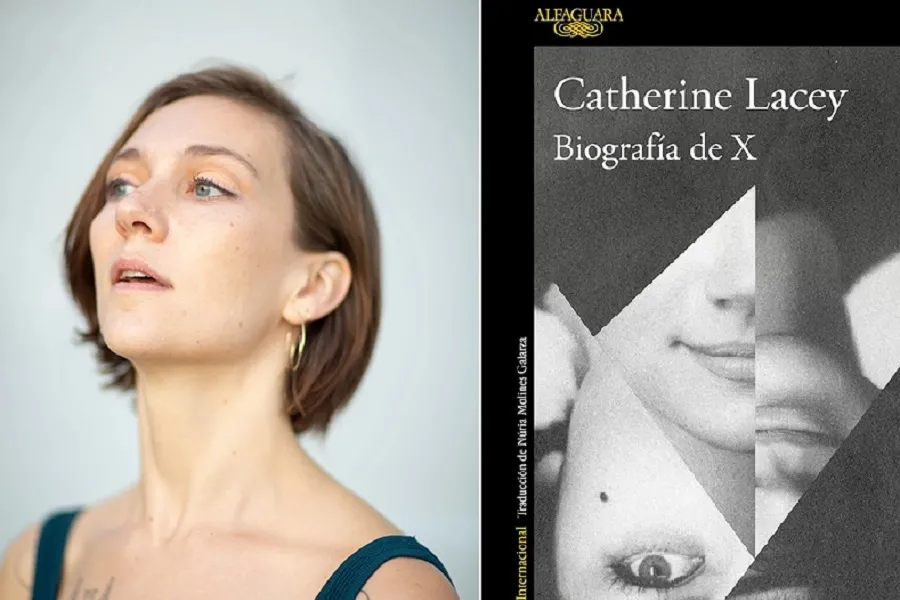Catherine Lacey: "cuanto más dispuesta estoy a fracasar, más disfruto del proceso de escritura"
La autora de la monumental y enigmática novela "Biografía de X" concedió una entrevista a LA GACETA, donde desmenuza, con precisión quirúrgica y destellos de ironía, su proceso creativo. Y es que Biografía de X no es solo una novela, es una máquina del tiempo rota, un espejo deformante que refleja una versión alternativa y distorsionada de los Estados Unidos. Versión Castellano e Inglés.

Por Daniel Medina
Catherine Lacey (1985), nacida en Tupelo, Misisipi, irrumpió con fuerza en el panorama literario anglosajón, ganándose rápidamente el favor de la crítica. A sus 30 años, su primera novela, Nunca falta nadie, fue elegida como el mejor libro del año en 2014 por publicaciones de renombre como The New Yorker y Time Out New York. Además, fue galardonada con el prestigioso Whiting Award, que anteriormente recibieron escritores como David Foster Wallace y Jonathan Franzen.
Este año llega a las librerías de Argentina su gran obra maestra: "Biografía de X".
Biografía de X, de Catherine Lacey, gira en torno a la figura insondable y desbordante de X, un ser que no es ni será, sino que siempre está siendo. Una artista de multitudes, de mil formas y ninguna, que deja su huella –o sus cicatrices– en la música, el cine y el arte conceptual, pero cuyo verdadero nombre, como todo lo que realmente importa, permanece oculto en sombras. Desde el inicio, somos guiados por su viuda: una narradora desgarrada que, tras la muerte de X, se sumerge en un viaje tanto de descubrimiento como de despedida, persiguiendo las incógnitas que su ausencia dejó flotando en el aire. Esa viuda que, como todos, nunca llegó a conocer del todo a X, ni siquiera cuando creía hacerlo.
La investigación de esta viuda se transforma en una odisea a través de un país dislocado. Una versión distorsionada de los Estados Unidos, fracturada por un muro que separa al norte del sur, donde el totalitarismo religioso ha impuesto su puño de hierro sobre la sociedad. Es en este contexto que X desafía las reglas, el tiempo, la historia misma, resistiéndose a las limitaciones de su época. Mientras su viuda escarba en su pasado, los ecos de esa nación alternativa van revelando las verdades que el arte de X esconde, todo mientras el lector camina sobre el fino alambre entre lo real y lo imaginario.
En esta búsqueda, la viuda –y nosotros con ella– empieza a preguntarse: ¿quién era realmente X? ¿Qué hay detrás del mito que ella misma construyó? La respuesta nunca es clara, ni lo será. Lo que queda es una novela monumental sobre la fragilidad de la identidad, la memoria y el arte. Un relato donde las fronteras entre la ficción y la realidad se desdibujan, donde lo íntimo y lo político se entrelazan en una danza compleja y trágica, siempre orbitando alrededor de esa figura inmortal y elusiva que es X, como un agujero negro que todo lo consume, todo lo transforma.
Sobre todo esto -y más- Catherine Lacey dialogó con LA GACETA, en la siguiente entrevista.
¿Cómo surgió la idea para Biografía de X?
He admirado las biografías reales durante mucho tiempo; pensaba que quería escribir una, pero sabía que estaba más allá de mis capacidades por muchas razones. Así que tomé la forma y la adapté a la ficción. Después de tener ese marco en mente, apareció la imagen de una viuda agraviada, y comencé a seguir su voz.
¿Cómo fue el proceso de escritura?
Lleno de falsas victorias, como siempre. Escribí de manera constante desde 2017 hasta 2020, pensé que había terminado, luego revisé mucho en 2020-2021, y finalmente edité y añadí algunas cosas a principios de 2022.
Acabo de ver el debate presidencial de Estados Unidos y por un momento pensé en tu novela, cómo esa ironía de un país dividido por un muro y un gobierno autoritario y religioso podría no estar tan lejos de la realidad. ¿Cómo surgió esa ucronía?
La única razón por la que creé ese trasfondo para la novela fue para que dos mujeres pudieran casarse en América del Norte sin que fuera un problema. También para que una artista como X pudiera existir de manera factible. Tuve que reescribir la historia para contar la historia como necesitaba ser contada. Tengo que seguir la lógica de lo que siento, en mi cuerpo, que es verdadero. No creo que el país en el libro sea muy diferente del que crecí, pero sí lo es en algunos aspectos clave.
Edith Wharton... Se la menciona un par de veces en la novela. Quería saber qué significa para ti.
Me encanta La casa de la alegría, especialmente. No recuerdo cómo se la menciona en la novela, ¡pero te creo si dices que está ahí! He olvidado muchas cosas de lo que he escrito.
Han pasado 10 años desde la publicación de tu primera novela Nobody is ever missing: ¿hay una evolución en un escritor? ¿Qué ha cambiado en ti? ¿Se aprende el oficio y la escritura se vuelve más fácil?
Mucho ha cambiado. Cuando escribes tu primer libro y no tienes idea de si alguien lo leerá, o si alguna vez se terminará o publicará, puedes escribir con una privacidad única en la vida. También hay lecciones en ese primer libro que sigues teniendo que reaprender el resto de tu vida. Las lecciones de cada uno son diferentes, y nadie las aprende por completo. Cuanto más confío en mis instintos y cuanto más dispuesta estoy a fracasar, más disfruto del proceso de escritura. En cuanto a si evoluciono, confío en el poema de WS Merwin sobre lo que John Berryman le dijo: en resumen, que nunca puedes saber si algo que escribes es bueno, y si necesitas estar seguro de que es bueno, entonces no deberías escribir.
Cinco consejos para jóvenes escritores:
Ve a dormir temprano y levántate temprano.
Cuida tu cuerpo.
Aprende a perder tus inhibiciones en todas las áreas de tu vida.
Lee en la cama a primera hora de la mañana.
Aprende otro idioma, o al menos inténtalo.
Cinco libros que te marcaron como escritora:
Speedboat de Renata Adler
Strangers on a Train de Jenny Diski
Sweet Days of Discipline de Fleur Jaeggy
The Door de Magda Szabó
Will & Testament de Vigdis Hjorth
VERSIÓN EN INGLÉS DEL ARTÍCULO:
Catherine Lacey (1985), born in Tupelo, Mississippi, made a powerful entrance onto the English literary scene, quickly winning over the critics. At just 30 years old, her first novel, Nobody Is Ever Missing, was named the best book of the year in 2014 by renowned publications such as The New Yorker and Time Out New York. She also received the prestigious Whiting Award, previously won by writers like David Foster Wallace and Jonathan Franzen.
This year, her great masterpiece, Biography of X, arrives in Argentine bookstores. Biography of X, by Catherine Lacey, revolves around the boundless and elusive figure of X, a being that is neither past nor future, but always becoming. An artist of multitudes, with a thousand forms yet none, who leaves her mark—or her scars—on music, film, and conceptual art, but whose true name, like everything that truly matters, remains hidden in shadows. From the outset, we are guided by her widow: a grief-stricken narrator who, after X's death, embarks on a journey of both discovery and farewell, chasing the mysteries that her absence left lingering in the air. This widow, like everyone else, never really knew X, not even when she thought she did.
The widow’s investigation turns into an odyssey through a dislocated country. A distorted version of the United States, fractured by a wall separating the North from the South, where religious totalitarianism has imposed its iron grip on society. In this context, X defies the rules, time, and history itself, resisting the limitations of her era. As her widow delves into her past, the echoes of that alternate nation reveal the truths hidden in X's art, all while the reader walks a tightrope between the real and the imaginary.
In this search, the widow—and we, alongside her—begins to ask: Who was X really? What lies behind the myth she built herself? The answer is never clear, nor will it be. What remains is a monumental novel about the fragility of identity, memory, and art. A story where the boundaries between fiction and reality blur, where the personal and the political intertwine in a complex, tragic dance, always revolving around that immortal and elusive figure that is X, like a black hole that consumes everything, transforming everything.
Catherine Lacey discussed all this—and more—with LA GACETA, in the following interview.
How did the idea for Biography of X come about?
I have admired real biographies for a long time; I thought I wanted to write one but I knew it was beyond my abilities for many reasons. So I stole the form into fiction— after I had that frame in mind, the sense of an aggrieved widow came to me and I started following her voice.
What was the writing process like?
Full of false victories as usual. I wrote from 2017-2020 steadily, thought I was done, then revised very heavily in 2020-2021, then edited and added a few things in early 2022.
I just watched the United States presidential debate and for a moment I thought about your novel, how that irony with a country divided by a wall and an authoritarian and religious government might not be so far from reality. How did you come up with that uchronia?
The only reason I made this backdrop for the novel was so that two women could marry in North America without it being an issue. Also so that a female artist like X could feasibly exist. I had to rewrite history to write the story the way it needed to be written. I have to follow the logic of what I feel, bodily, to be true. I don’t think the country in the book is very different from the one I grew up in, but it is different in a few key ways.
Edith Wharton... She is mentioned a couple of times in the novel. I wanted to know what it means to you.
I love The House of Mirth especially. I don’t remember how she is mentioned in the novel but I believe you that she is there! I have forgotten a lot of what I’ve written.
10 years have passed since the publication of your first novel "Nobody is ever missing": is there an evolution in a writer? What changed in you? Do you learn the craft and does writing become easier?
So much changed. When you write your first book and have no idea if anyone will ever read it or if it will ever be finished or published, you can write with a once in a lifetime privacy. There are also lessons in that first book that you keep having to relearn for the rest of your life. Everyone’s lessons are different and no one ever totally learns them. The more I trust my instincts, and the more I am willing to fail, the more I enjoy the writing process. As for whether I evolve, I trust WS Merwin’s poem about what John Berryman told him— loosely, that you can never know if anything you write is any good and if you need to be sure that it’s good then you shouldn’t write.
Five tips for young writers:
Go to sleep early and wake up early.
Take care of your bodies.
Learn to lose inhibitions in all areas of your life.
Read in bed first thing in the morning.
Learn another language, or at least try to.
Five books that marked you as a writer.
Speedboat by Renata Adler
Strangers on a Train by Jenny Diski
Sweet Days of Discipline by Fleur Jaeggy
The Door by Magda Szabo
Will & Testament by Vidgis Hgorth













